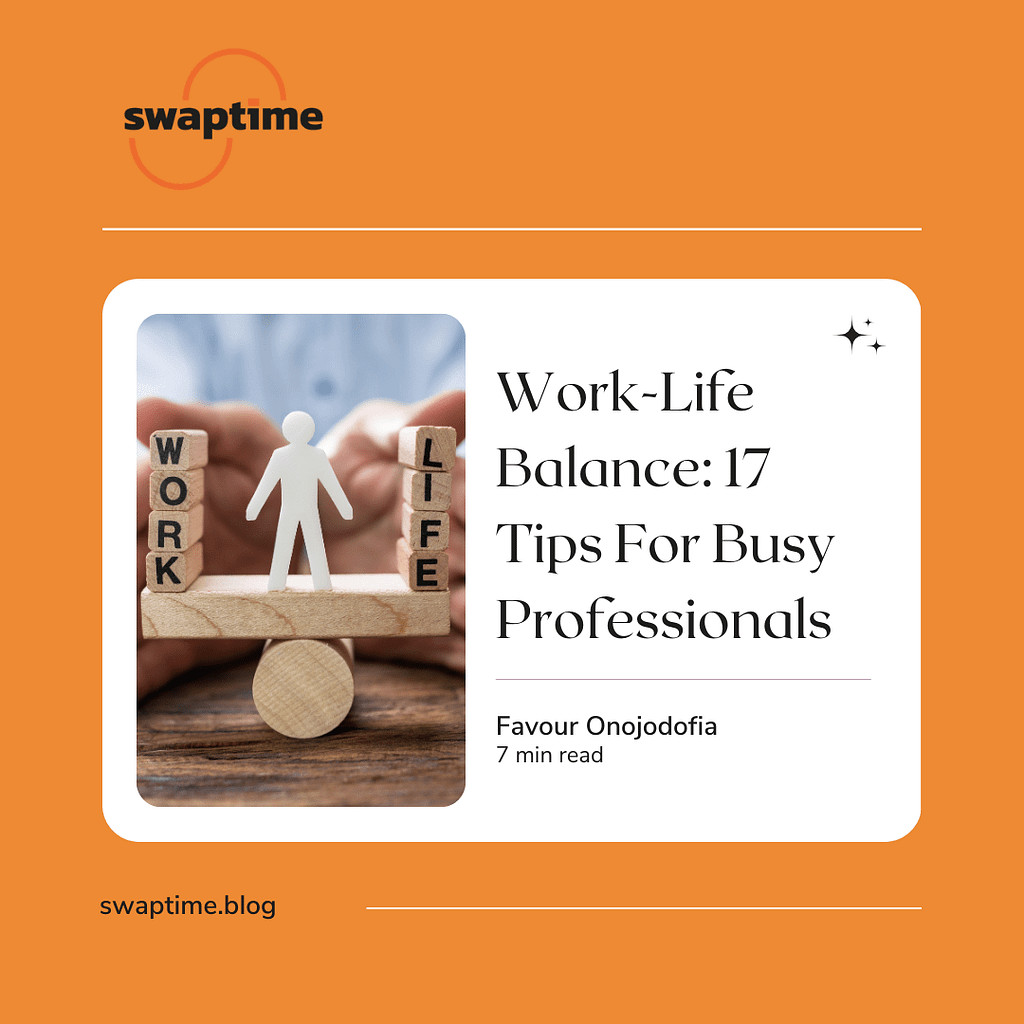As a creative, business owner, entrepreneur, or freelancer, you’d agree with me that finding the right balance between work and life can seem like an elusive goal, especially for busy professionals. Juggling the demands of a career with personal responsibilities can often leave us feeling overwhelmed and burnt out. However, achieving a healthy work-life balance is important for our well-being and happiness. In this article, we talk about why work-life balance is important and share some simple yet effective tips to help you navigate this balance.
What does work-life balance mean?
Work-life balance refers to the equilibrium between the demands of a person’s professional life and personal life. It involves the ability to effectively manage responsibilities and commitments related to work, such as job duties, deadlines, and even career aspirations, while also allocating time and energy to personal goals, relationships, and leisure activities. To achieve work-life balance, you have to prioritize both your professional and personal well-being, maintaining boundaries between work and non-work activities, and striving for harmony in all aspects of life. It’s about finding a good rhythm that allows you to thrive professionally as you nurture your health, relationships, and the quality of your life in general. It feels like a lot already. Let’s see why work-life balance is important.
Why is work-life balance important?
- It contributes to your overall well-being and mental health by reducing stress and preventing burnout. When you can maintain a balance between your work and personal lives, you are less likely to experience feelings of overwhelm and exhaustion, leading to improved mental clarity and emotional resilience.
- Work-life balance promotes healthier relationships with family and friends, as it allows you to dedicate time and attention to nurturing these connections.
- A balanced lifestyle promotes physical health by providing opportunities for rest, exercise, and self-care, which are important for maintaining your energy level and preventing health issues associated with chronic stress.
- Work-life balance can increase productivity, creativity, and job satisfaction, as you’re better able to recharge and approach your work with renewed focus and enthusiasm.
- Prioritizing work-life balance enables you to lead a more fulfilling life, where you can thrive both personally and professionally.
17 tips for navigating work-life balance as a busy professional
- Set boundaries
- Prioritize tasks
- Learn to delegate
- Schedule downtime
- Practice self-care
- Learn to say no
- Create work-life integration
- Communicate openly
- Set realistic expectations
- Seek support
- Set technological boundaries
- Practice mindfulness
- Take regular breaks
- Set aside “me” time
- Establish rituals
- Embrace imperfection
- Evaluate and adjust regularly
1. Set boundaries
Setting boundaries between work and personal time can be tricky. It’s a constant struggle between finishing up on deliverables and finding time for yourself. But you must learn to establish clear boundaries between work and personal time. Define specific work hours and stick to them as much as possible. Avoid checking work emails or taking work calls during off-hours unless necessary. When you’re off the clock, make a conscious effort to disconnect from work and focus on your personal life.
2. Prioritize tasks
Learn to prioritize tasks based on their importance and urgency. Make a to-do list at the beginning of each day and tackle the most critical tasks first. This not only helps you stay organized but also prevents you from feeling overwhelmed by trying to do everything at once. At the end of the day, it’s easier to rest knowing you’ve delivered on what’s important.
3. Learn to delegate
Don’t be afraid to delegate tasks both at work and at home. You can’t do everything on your own, and it’s okay to ask for help when needed. Trying to do everything by yourself makes it harder to meet up with the deadlines. Delegating responsibilities not only lightens your workload but also allows others to contribute and grow. A part of delegating is collaborating with other professionals in projects that play to your strengths.
4. Schedule downtime
Yes, just as you schedule meetings and appointments, make sure to schedule downtime for yourself. Take a few minutes off to get your mind off work. Go for a walk, practice mindfulness, listen to music, or talk to your loved ones. Prioritizing leisure activities is important for recharging your batteries and maintaining your mental and emotional well-being.
5. Practice self-care
Self-care should not be an afterthought. Make it a priority in your daily routine. This includes getting enough sleep, eating healthy, exercising regularly, and engaging in activities that bring you joy and relaxation. Ask yourself “What can I do to spark joy today?”. Taking care of yourself physically, mentally, and emotionally helps you to perform at your best both at work and in your personal life.
6. Learn to say no
It’s okay to say no to additional commitments that don’t align with your priorities or values at the moment. You can’t do everything all at once at the same time. Overcommitting yourself can lead to stress and burnout. Knowing you have limited time to deliver on tasks helps you to be selective about where you invest your time and energy. Saying no allows you to focus on what truly matters to you.
7. Create work-life integration
In this case, Instead of viewing work and personal life as separate entities, strive for integration whenever possible. Look for opportunities to combine simple work tasks with personal activities, such as taking a walk during a work break or attending a networking event that aligns with your interests as an individual. Remember, an integration should make it easier for you, not more tedious.
8. Communicate openly
Practice open communication with your employer, employees, colleagues, and family about your need for work-life balance. Discuss flexible work arrangements, such as adjusted hours or fewer tasks that can accommodate your personal needs while still meeting your professional obligations.
9. Set realistic expectations
Be realistic about what you can accomplish in a given timeframe and set achievable goals. Don’t think you can complete tasks that would take 3 months in a month. Avoid setting unrealistic expectations that only set you up for disappointment and frustration. With realistic expectations, you can pace yourself and have time for other things.
10. Seek support
Don’t hesitate to seek support from friends, family, or a professional counselor if you’re struggling to find balance. Talking to someone can provide valuable perspective and help you explore strategies for managing stress and achieving greater balance in your life. Seeking support is not a sign of weakness. A fresh perspective might just be what you need to find what works for you.
11. Set technology boundaries
Technology is great but sometimes it can be a hindrance to your goals. Limit your screen time and establish boundaries with technology to prevent work from encroaching on your time. Consider implementing “no-device zones” during family meals or recreational activities to help build better connections with loved ones and promote mental relaxation.
12. Practice mindfulness
Add mindfulness practices into your routine to help you stay present and reduce stress. It can be meditation, deep breathing exercises, or simply taking a few moments to appreciate the present moment. Mindfulness can help you stay grounded amidst the chaos of a busy schedule. So, take your eyes off the screen for a minute and consider your environment.
13. Take regular breaks
Don’t underestimate the importance of taking breaks throughout the workday. Stepping away from your desk for short breaks can help prevent burnout, improve productivity, and enhance creativity. Use breaks to stretch, go for a short walk, talk to your colleagues, or engage in activities that help you relax.
14. Set aside “me” time
Carve out dedicated time for yourself each day to indulge in activities that bring you joy and fulfillment. Whether it’s reading a book, pursuing a hobby, or simply enjoying a quiet moment alone, prioritizing “me” time helps in maintaining a sense of identity and happiness outside of work.
15. Establish rituals
Create daily or weekly rituals that help you transition between work and personal life. It can be a morning routine to start your day on the right foot or an evening ritual to unwind. Having consistent rituals can provide structure and stability in an otherwise hectic schedule. At least, it tells your brain that it’s time to do something.
16. Embrace imperfection
Sometimes, it’s okay to accept that achieving the perfect balance between work and life is unrealistic and often unattainable. You’ll likely not get a 50:50 balance at any point. Instead of striving for perfection, embrace the imperfection of the situation and focus on making small, sustainable changes that align with your values and priorities at a time.
17. Evaluate and adjust regularly
From time to time, assess your work-life balance to identify areas that need adjustment. Look at what’s working well and what could be improved, and be willing to make changes as needed. In creating balance, the key factor is to be flexible and willing to adapt to new changes as they come.
Conclusion
Finding work-life balance is an ongoing process that requires intentional effort. You have to be willing to put in the work that is required. Work-life balance can mean different things for different people. Set your priorities per time and define what it would mean for your professional and personal life. Strive to give your best to your professional aspirations but don’t neglect yourself while at it. Remember it’s not about achieving a 50:50 balance but rather striving for what works and makes you happy.
ALSO READ:
Collaboration as a Creative: 8 Reasons You Should Consider It
Swaptime in 3 Easy Steps: Discover the Power of Collaboration
Swaptime – Growing Businesses with Skill Exchange



